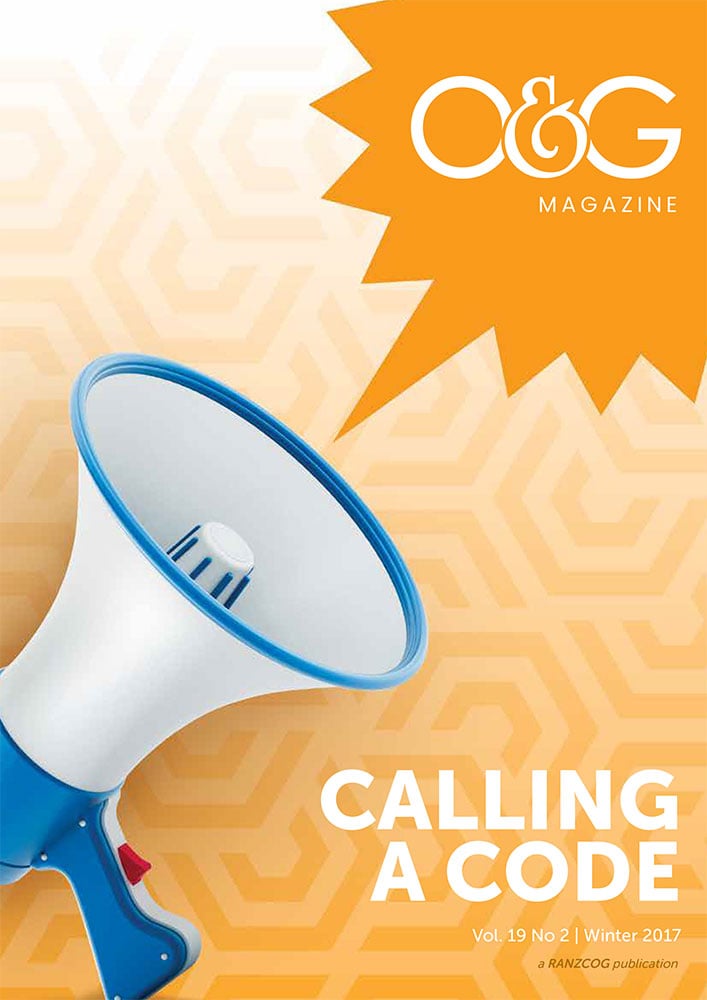The phone rings at 2am: Code Pink, the code for urgent delivery, gets me into action. I live two minutes from the hospital without pants on or three minutes with pants on. As I drive in, three minutes later, I’m thinking about the possibilities: fetal distress, antepartum haemorrhage or shoulder dystocia, to mention a few.
I arrive at the unit and am directed to the birth suite where a mother is on the floor with the baby’s head out, no progress and a BMI of 45. It has already taken three minutes and will take another minute or so to get her on the bed, so I decide to try to deliver as she is. This means thinking through the various manoeuvres upside down. Though the suprapubic pressure is not on, it is possible to get ‘knees to nipples’ on all fours. After an episiotomy has been carried out, internal rotation is attempted, but is not successful. Finally, the posterior arm is delivered and all is well.
Shoulder dystocia is an obstetric emergency that can occur out of the blue and all practitioners, medical and midwifery, involved in deliveries should know and be able to carry out the various manoeuvres to assist in the safe delivery of the baby. In rural areas, except where the doctor is doing the delivery, it is a midwife problem until help arrives. For this reason, it is important that regular practice sessions are held, such as those in the PROMPT program.
The problem
Shoulder dystocia involves the trapping of the anterior shoulder behind the pubic symphysis, though rarely it is the posterior shoulder that is trapped by the sacral promontory. The incidence varies from series to series and to some extent depends on how you diagnose it. In two large series, one of 34,800 the other of 267,228 cases, the incidence varied from 0.58 per cent to 0.70 per cent.1 From my point of view, at least two of the procedures, outlined below, need to be carried out to make the diagnosis, and numbers are usually extracted from hospital databases, where there is a problem in that garbage in leads to garbage out, so figures may not always be accurate.
Apart from the mechanical problems, there are also complications for both mother and baby. For the mother they include postpartum haemorrhage (PPH), perineal trauma (including third- and fourth-degree tears), not to mention the psychological trauma and difficulty with the bonding process. For the baby, the major problems may be death on the perineum (a disaster), hypoxic encephalopathy (there is a drop in pH of 0.04 per minute after delivery of the head), brachial plexus palsy and other birth trauma.
Can it be predicted?
Risk assessment for predicting shoulder dystocia has a low positive predictive value. Risk factors can be divided into a) antepartum and b) intrapartum. The antepartum risk factors include i) previous shoulder dystocia, ii) clinical or ultrasound suspected large baby, iii) diabetes, iv) BMI > 35 and v) induction of labour. The intrapartum include i) prolonged first stage of labour, ii) secondary arrest, iii) prolonged second stage, iv) oxytocin augmentation and v) assisted vaginal delivery. Most cases of shoulder dystocia occur out of the blue with no predictive factors and normal-sized babies.
Management
The diagnosis is made when there is difficulty delivering the shoulders using normal traction to the head, which must be in line with the fetal spine, without any lateral flexion that may predispose to brachial plexus trauma.
With any unexpected obstetric outcome the first thing to do is call for help; there will need to be at least two people to perform McRoberts manoeuvre (this could involve the partner). Inform the woman that there is a problem with the shoulders and that she will need to be appropriately positioned, which means buttocks at the edge of the bed. We have a double bed in one of our units and so it is easier to bring the buttocks to the side of the bed rather than move her to the end.
In rural hospitals, apart from the Code Pink in our case, a Code Blue or MET call should be made, particularly out of hours when the night staffing is reduced, to ensure there are plenty of people available. The baby needs a carer and maybe resuscitation, there needs to be a scribe and people to cope with the possible PPH. If too many people turn up they can always be shooed away.
The important factor is the length of time from the birth of the head until the delivery of the baby to reduce the change in fetal pH. There is also a difference between whether the woman has an epidural in situ or not as the ultimate manipulation, delivering the posterior arm, is extremely painful without an epidural yet may be the first manoeuvre if she has an epidural.
Manoeuvres possible
- McRoberts manoeuvre: after getting buttocks to the edge of the bed it involves ‘knees to nipples’, which means flexion and abduction of the hips. This results in flattening of the lumbar lordosis and altering the angle between the sacral promontory and the pubic symphysis. Allow 30 seconds.
- Suprapubic pressure (steady): It is important to identify which side of the mother the fetal back is located, as that enables you to determine the direction of suprapubic pressure. It is important that the person doing this knows how to do it and may need instruction if they have not done it before. The hands are placed at the posterior aspect of the anterior shoulder, just like in cardiac massage, and steady pressure is applied to try and adduct the shoulder and move it into a diagonal diameter; an attempt to deliver the shoulder is then carried out. Allow 30 seconds.
- Suprapubic pressure (rocking): the hands are in the same position as in 2, but pressure is applied intermittently with attempts at delivery of the shoulder. Allow 30 seconds.
- Internal manipulation: for this it may be necessary to cut an episiotomy, even though it may be difficult. The first manoeuvre involves inserting the appropriate hand to apply pressure to the posterior aspect of the anterior shoulder, so if the fetal back is on the mother’s left, the right hand is inserted into the vagina from the posterior aspect of the pelvis where there is more room and using the ‘Pringle manoeuvre’ (used to get the last Pringle out of the tube), which involves all the digits coming together to form a pyramid that can be inserted into the posterior region of the vagina and then expanded so the whole hand then moves to the posterior aspect of the anterior shoulder and applies pressure to move the shoulder into a diagonal diameter. If this doesn’t succeed then the other hand can be placed, by the same mechanism, on to the anterior aspect of the posterior shoulder and attempted rotation. Again, allow 30 seconds for these manoeuvres.
- If the above manoeuvre fails, the hands can be reversed, without taking them out of the vagina, so the movement is carried out in the reverse direction, that is, anterior of the anterior shoulder and post of the posterior shoulder and rotate in the opposite direction and attempts at delivery of the shoulder should be made. Allow 30 seconds.
- Delivery of the posterior shoulder: this is the final manipulation tried if a woman doesn’t have an epidural, but may be performed after the simple procedures if she has an epidural in situ. The appropriate hand is inserted into the vagina, in other words. the right hand if the back is on the right and left hand if the back is on the left. The arm is identified and the hand moves down the arm to try and grasp the hand, which is then pulled over the fetal abdomen and chest then over the face and removed. It may be difficult to find the hand, you can find the elbow and perform a variation of Pajot’s manoeuvre, where pressure is applied to the cubital fossa to flex the elbow and bring the hand into range.
- If these measures do not work, you can turn the woman on all fours and repeat, though at a faster rate.
- Fracturing the clavicle by pressure on the mid-point of the clavicle will result in collapse of the shoulder and may result in delivery.
- Zavanelli manoeuvre has been described, pushing the head back into the vagina then carrying out a caesarean section, but I have never performed this manoeuvre. In a rural setting where theatre staff are not on site, there would be a very high risk of adverse outcome because of the delay in the delivery.
- Cord gasses should be performed after the delivery and results communicated to those looking after the baby.
Post delivery
It is important that the mother and partner are informed about the complication with an explanation of what happened. It is important to speak to the doctor who has looked after the baby and, if necessary, carry out an examination looking for signs of trauma. The baby needs to be under increased observations.
Always be aware of the possibility for a PPH and perineal trauma up to and including fourth-degree tears. Always perform a rectal examination to assess the sphincter integrity and do a vaginal examination after the repair to ensure there are no lost packs.
Documentation
This is very important as, if it wasn’t written down, it didn’t happen. The PROMPT Manual has a good example of the information that needs to be recorded, so you don’t need to re-invent the wheel. Document the time of delivery of the head, the time the diagnosis was made and assistance called for and then the time taken and description of the manoeuvres carried out and finally the time of delivery of the trunk; after this details like Apgar, resus carried out, blood loss and any other trauma that may have happened can be recorded.
I performed a VBAC and did a mid-cavity forceps delivery, for non-reassuring CTG and had trouble with the shoulders, ending with delivery of the posterior arm. The paediatrician stated that there was an Erb’s palsy, though not the arm involved, that, over time, needed surgery. I had noted in the operating report that the position of the head was left occiput anterior, and station 1cm below the spines. It wasn’t until I got the solicitor’s letter that I realised it was the posterior arm involved, which meant it wasn’t the delivery that caused the problem. Adequate documentation saved me from a lengthy court case.
Any shoulder dystocia should be included in the perinatal audit that is carried out, to ensure the process was correct. Again, as shoulder dystocia is often unpredictable, it is important that regular drills are carried out. In a rural setting, midwives are often the primary operator until medical help arrives and so it is important that there is collaboration between midwives and doctors.
Conclusion
VMIA (Victorian Managed Insurance Authority), ‘sponsors’ of PROMPT, statistics have shown a marked decrease in the number of major claims that involve brachial plexus palsy and cerebral palsy since the introduction of PROMPT and FSEP. All maternity hospitals should have regular training sessions to deal with obstetric emergencies so that all staff are adequately trained. This is particularly important in rural and regional hospitals where night-time medical cover may be minimal.





Leave a Reply